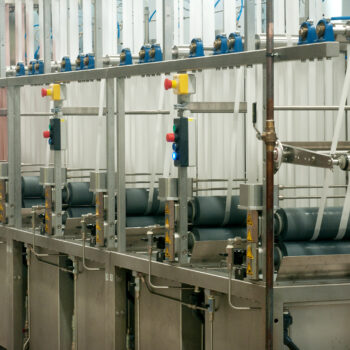Generally, a fiber can be dyed either by substrate impregnation (mechanical adsorption of the dye onto the fiber) or through chemical affinity between the dye and the fiber.
THERMOSOL PROCESS
The Thermosol process is a continuous dyeing process based on the mechanical adsorption of the dye onto the fiber, where insoluble dyes and pigments are deposited onto the fiber.
This process can be divided into 4 well-defined steps:
- Color impregnation in the bath.
- Pre-drying.
- Thermofixation.
- Washing.
- Drying.
1. Color impregnation
During this process, the fabric is submerged in the dye bath and then squeezed in a foulard at a known pressure, which determines the amount of dye the textile will have throughout the process and also allows for adjusting the fabric’s absorption.
Higher applied pressure leads to lower absorption.
For effective and uniform color impregnation across the textile, its quality is crucial, as it must maintain homogeneous hydrophilic conditions throughout.
The dye bath conditions, such as pH and bath ratio, are also vital. The bath ratio is defined as the amount of dye per total liters of prepared dye.
2.Pre-drying
Once the fabric is impregnated, pre-drying occurs, during which the fabric reaches a temperature between 80-90°C. The primary goal is to increase dye diffusion into the fabric.
It’s crucial for the fabric to leave the pre-drying stage with homogeneous humidity and temperature conditions.

3. Thermofixation
Thermofixation involves subjecting the fiber to a temperature between 160 and 210°C for a set time. This step is where the dye is fixed to the fiber.
For proper fabric dyeing, three stages occur:
- Dye diffusion to the fiber surface.
- Dye adsorption by the fiber surface. The amount of material adsorbed depends on the temperature, adsorbate quantity, and available surface.
- Dye diffusion from the fiber surface to the interior. In this final phase, the geometry and volume of dye molecules, as well as the temperature applied in the process and the residence time within the chamber, are crucial.
4.Washing
Once the dye is fixed onto the fiber, excess dye and other unused dyeing auxiliaries remaining on the already thermofixed fabric need to be removed.
For this, a washing line with reducing baths is used to eliminate excess dye and ensure good rubbing fastness of the finished product.
5.Drying
The final part of the process involves drying the fabric in a hot air convection chamber at a temperature around 100-110°C.
PAD-STREAM PROCESS
The Pad-Steam process is a continuous dyeing process where the dye attaches to the fiber through a chemical bond. This process can be divided into 3 well-defined steps:
- Color impregnation.
- Dye fixation using steam.
- Washing.
- Drying.
1.Color impregnation
Similar to the Thermosol process, in this stage, the fabric is submerged in the dye bath and then squeezed in a foulard at a known pressure. This determines the amount of dye the textile will have throughout the process and allows for adjusting the fabric’s absorption.
2. Fijación del color mediante vapor
After impregnation and draining, the fabric is placed in a steam chamber where the chemical reaction that fixes the dye to the fiber occurs, either through an ionic or covalent bond depending on the dye type used.
To reach the required reaction temperature, the chamber is heated using saturated steam.
Using saturated steam aims to achieve maximum dye penetration and penetration of other involved chemicals into the fiber, preventing them from drying on the surface and causing stains on the fabric.

Therefore, it’s crucial for the steam chamber to maintain constant steam percentage and an absence of air during this process to achieve maximum dye penetration. Additionally, suitable pH and temperature conditions are necessary to promote the bond between the fiber and the dye.
3.Washing
Finally, after color fixation in the steam chamber, that is, once the dye’s reaction with the fiber is complete, unfixed dyes need to be removed.
These include both dyes that haven’t reacted and those that have hydrolyzed during the process.
Other chemicals used to facilitate the reaction also need to be removed.
To eliminate these, a washing line is used at the steam chamber’s exit, as these unfixed products are weakly trapped inside the fiber through weak interactions that can easily desorb during washes.
This part of the process is crucial to enhance the finished product’s fastness.
4.Drying
The final part of the process involves drying the fabric in a hot air convection chamber, at a temperature ranging between 100 and 110°C.
